SUMMARY
- Lockdown 2 has been introduced in the light of pressures on hospital beds and increased viral spread.
- There are signs the second wave might be slowing already
- This might have preceded the lockdown
- Is mass testing an alternative to lockdown?
- Vaccine news
- It is more important than ever to look after ourselves.
Introduction
So here we are in Lockdown 2. This fudge between the competing demands of the ‘economy’ and ‘health’ is very different from the panic of the first lockdown. Almost thankfully, it had been overshadowed by the nail-biting US election, a welcome distraction from COVID19 headlines. A Biden win is indeed an optimistic moment amid the gloom of this pandemic winter.
My first day in lockdown involved dropping my grandson off at pre-school, and food shopping in Totnes where most of the shops were shut and only a few souls sipping coffee outside in the cold. There was a queue outside the butchers – never seen that before. Traffic seemed to be pretty much at normal levels and what has been cancelled can be pretty much defined as anything involving “fun”, or indeed, culture. Rush hour traffic in Plymouth, unlike Lockdown 1 also seemed at normal levels too.
Even in ‘enlightened’ Totnes, there remain plenty of vulnerable people around, though far more than the less affluent Plymouth. Here in the South West, we are just experiencing our first real wave.
The big picture
For me hospital admissions are the best way of looking at the natural history of the pandemic playing out. They are easy to count and reported daily. At the peak of the first wave, there were 20,000 people in hospital with complications of COVID19, now there are 13,000, so the second wave is of considerable size. Thankfully, there seems a definite flattening out of the curve of daily hospital admissions, which has to be seen as good news at this early phase of winter with its pressures on the NHS.
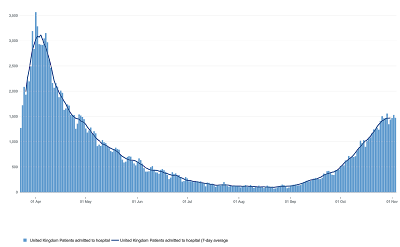 |
| COVID Hospital Admissions |
Deaths I hope, will be lessened by better treatment and management of the illness and are subject more inaccuracies, yet the trends tell the story too. Despite lagging behind the number of cases and hospital admissions by a few weeks, they also seem to be going in the right direction just now.
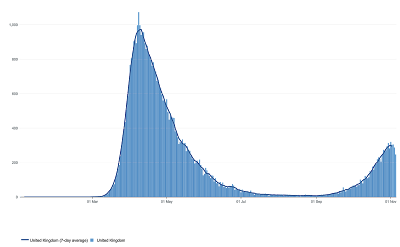 |
| COVID19 related Deaths |
So the latest data is encouraging and sets up hope that this wave will be more manageable than the last. Predictions of a longer, lesser wave is looking more likely, though things can rapidly change as the daily data rolls in.
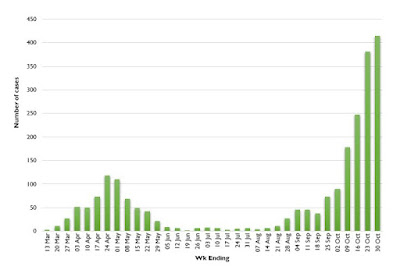 |
| Hospital admissions in Plymouth |
So is the lockdown the right thing to do?
It’s interesting to note that the deceleration in the rate of cases might have started before the lockdown. This is not as much of a shock as it might seem as the news had been stark and behavioural changes don’t always wait for government advice, particularly a government so laggard in its response.
Personally, I think it’s reasonable to assume that lockdowns “work” in that they postpone viral spread, albeit shifting cases, admissions and problems to the future until the onset of longer days spell the end of wave, as it did first time around.
Our response, costing so much to the younger generation in particular; for that half of the population with few savings and which hits the underprivileged so hard is driven by our need for medical care. The notion of rationing of ITU beds is unthinkable, not just for politicians, but for anyone who accepts modern treatment as the norm.
Hi tech, precise care is available in qualities and of a quality never know during past pandemics. In other words, we can save people with advanced care delivered by bigger hospitals, better trained staff, amazing technology and treatments for a condition which in my youth would have led to had a couple of visits from the GP before recovering at home or meeting the undertaker. That the average of death is still over 80, and the average age of hospital admission is 58 bears testament to this incredible level of support.
Those who see the restrictions as unjust, needless impositions don’t seem to understand that the NHS cannot, after the ravages of politically driven austerity, cope with uncontrolled waves of infection. Nigel Farage, ever the careless opportunist, has found another bone to chew!
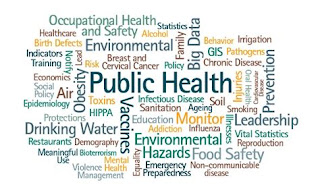 |
| Public Health needs to recover |
Of course adequate control of the virus involves imprisoning it within cases and families until it dies out rather than it forever leaping to the next host. Find, Test, Trace, Isolate and Support, (FTTIS) can work, but here, as well as in the rest of Europe, the low priority of public health over the needs of the ‘economy’ has weakened system and have been unable to prevent a second wave and may not prevent a third unless there is a big change in its ethos and organisation.
So given our failed FTTIS system are there alternatives to intermittent lockdowns?
Liverpool mass testing experiment
In Liverpool testing is being made available for everyone weekly, in the hope that a normal result will allow people to go about their normal lives.
However, the pre-symptomatic phase will mean many will still spread the virus before knowing they have it, even with regular testing. Worries have also been expressed that the increased contact between people leaving their homes, travelling to testing centres, being tested and going home again is a risk of transmission in itself.
 |
| Picking up COVID at the testing station? |
Of course, a test may have become positive the day after the reassurance of a negative test and the relieved tested person will then spread the virus without symptoms for a few days before a hint on infection, if that comes at all.
COVID19 switches of the manufacture of interferon, a chemical important as a first line defence against infection, but also a chemical which gives you early symptoms. So, the Liverpool experience is a worthy trial and perhaps an example of good practice in trying something as an experiment out before we try it out more widely. Results will be confounded by the peaking of cases there before mass testing started.
I cant help but think a better trial would have involved care home staff being tested before each shift, but the situation in Liverpool was seen as desperate.
So it’s an experiment, another hope that gadgets and technology will get us out of this mess. The test itself is a lateral flow test, rather like pregnancy tests. It has been manufactured in China for an American company supplied to the UK by micro-company called “Tried and Tested” which, it seems, operates out of a house in Oxfordshire. Potential UK manufacturers are, hardly surprisingly miffed at the difference between the patriotic rhetoric of the Johnson club and the cold reality of our shenanigan driven procurement system. Little change there. Literally.
If positive, a PCR test will follow with the result usually taking a couple of days, so a positive lateral flow test followed by a negative PCR test will cause confusion. Uncertainty also exists as to how many people will come forward. The mandatory testing in Taiwan and China has contained outbreaks, and the restriction in personal freedom that brought meaning lesser restrictions for everyone else, but the time for that here is long gone. It remains the gold standard for early pandemic control.
Our own immunity.
There is more to the behaviour of the pandemic than meets the eye – Behaviour has changed. B cell (antibodies) and T cell immunity might well be having a big impact, as might supplementing with Vitamin D. The situation if different from the first wave, which was seeded without us knowing, for which we had poor preparation, and very little experience.
That there are 10 times fewer cases in London than in the North East suggests that previous exposure of Londoners during the first wave is having a positive effect. That immunity is a clear cause for optimism; if it continues.
In the US, cases continue to surge, driven by the dreadful health of the population. The ‘typical’ American diet is the worst ever eaten by humankind and is taking its toll, along with high levels of social and racial inequalities, air and other pollution as well as 70 million people daft enough to vote for Trump’s denigration of anything containing the word “public”, including health.
Vaccines to the rescue?
A vaccine is one step nearer too after the announcement by Pfizer and BioNTech that their RNA vaccine is effective in phase three trials. The news is based on the first 94 people in the trial of 45,000 participants to develop COVID19, 90% of whom were in the placebo arm. This is good news and there will soon be more data will be in the pipeline in safety and side effects.
It’s a novel approach, manipulating our cells into making spike proteins which then generate an immune reaction, protecting us from infection agains the real thing.
The bad news is that the vaccine needs to be kept at a very cold minus 80 deg C. From the factory of manufacture to the upper arm muscle where it will end up, this might be a stumbling block. Hopefully there will be results from the other trials coming along soon and will lead to a nuanced view on which vaccine is the most practical, effective and safe. We still have the winter to get through.
Personally, I wont be in the front of the queue right now to get a vaccine. I always advised patients not to rush to try new blockbuster drugs as they often proved a disappointment and have been very cautions with treatment for my own MS, but there is no queue to be in the front of as yet. When there is, way in front of me will be those at risk, health and care staff and public sector workers to name but a few.
Looking after ourselves?
We have a government who consider that the pandemic and even climate change will be solved by technology, tests, gadgets and Apps. Underpinning this no doubt are the consequent opportunities for economic activity and expansion of the private sector into health. Behavioural change is less politically exciting, though far more effective. In other words, looking after ourselves.
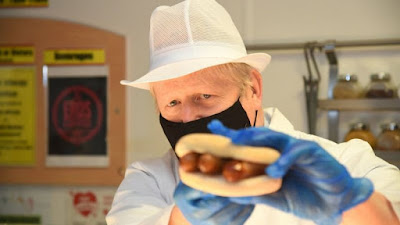 |
| PUBLIC HEALTH – BoJo style |
Early in the pandemic I posted on how to get ready for COVID19 and little has changed apart from more evidence about the effectiveness of Vitamin D supplementation.
I wonder how many people have changed their lifestyle in positive ways? In Italy, so hard hit by the first wave, it seems some have, though changes are modest, with a small reduction in smoking and evidence of more traditional dietary changes. Sadly, 47% of respondents to a UK survey thought they had put on weight!
According to Action on Smoking and Health, over a million people have quit smoking which has got to be good news despite some confusing headlines about protective effects of nicotine.
It seems the number of people taking Vitamin D has increased too though numbers are hard to come by. A survey by Mintel reports 60% of people in the UK have taken supplements in the last year with strong growth in VItamin D sales. We now spend about £500m annually on supplements, most of which I have to say are not needed. Even Handsfree Hancock, our health secretary has quietly suggested Vitamin D might be a good idea. Studies are under way to get a more definitive answer, but will take 6 months to complete, and there really is no point in waiting.
When I was diagnosed with MS, I thought I would take 5000iu daily until the definitive studies are done – I’m still waiting. There is no money available to properly research such a cheap product, even though it a powerful and essential hormone in the steroid family with important roles in immunity.
The lockdown has postponed much of the bedrock of society for a month. Culture, sport and fun are greatly diminished, perhaps sadly destroyed. Social isolation and poverty are big worries for many. We all need to call, text, Zoom and use whatever means we can to keep in touch and share the burden along with all the usual plethora of activity which makes us human and humane.
With Biden in power in the US, vaccines in the pipeline and evidence of our curve flattening, at least there are silver linings on our early winter clouds.
 |
| Silver linings……… |
.
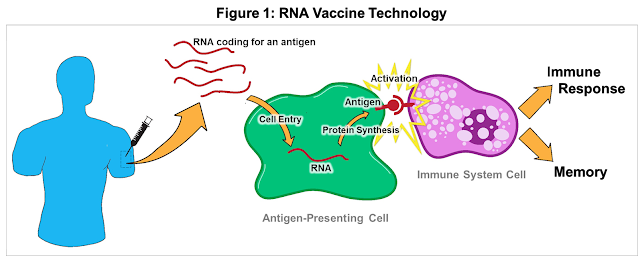
You have not commented on the cycle threshold in regard to PCR testing, if set too high it producing mostly false positives.
Colin, the figure of -80 C seems suspiciously close to the temperature of dry ice -78 C. Has it been a rounding for the general public to swallow. If so then then the maintenance of the temperature in the more developed will be relatively simple, just a cool box and a supply of solid CO2. Even colder temperatures are used on farms even in developing countries by immersing the biological samples in liquid nitrogen -196 C. I know it is one extra bit in the logistics, but a relatively simple to solve.